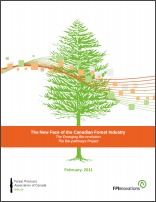
FPAC unveils bioeconomy strategy
February 4, 2011
By CNW
NEWS HIGHLIGHT
 FPAC unveils bioeconomy strategy
FPAC unveils bioeconomy strategy
The Forest
Products Association of Canada (FPAC) has released a breakthrough study that
shows how the Canadian forest sector can become a pivotal player in the
marketplace by thriving in the new bio-age.
 |
|
|
Feb. 4, 2011, Montreal – The Forest
Products Association of Canada (FPAC) has released a breakthrough study that
shows how the Canadian forest sector can become a pivotal player in tomorrow's
marketplace by thriving in the new bio-age. The bioeconomy is an exploding
global market worth trillions of dollars that reflects a growing environmental
sensibility and a paradigm shift towards products that come from natural
renewable sources.
The study, called The New Face of the Canadian
Forest Industry: the Emerging Bio-Revolution,
demonstrates how the forest products industry of Canada is positioned to take
advantage of the new bioeconomy and exploit a potential global market of around
$200 billion for bioenergy, biochemicals, and biomaterials that can be
extracted from trees. These products include everything from renewable fuels to
lightweight plastics to non-toxic chemicals and food additives.
The project was guided by FPAC with
essential partners, including FPInnovations and the Canadian Forest Service,
with help from experts in fields such as biotechnology and carbon
analysis.
"This has extraordinary implications
for Canada's future prosperity," "This study produced a roadmap for a
new business model that consolidates the economics of wood and pulp and paper
production by extracting additional economic value from each tree
harvested," says Avrim Lazar, president and CEO of FPAC.
The report is the second phase of an
exhaustive research study on how to best position the next-generation forest
products industry by extracting maximum value from every tree. The first phase
broke new ground by showing the economic and job benefits of adding new high-value
products into existing lumber and pulp and paper mills. These integrated
operations could increase the job potential by up to five times that of
stand-alone bioenergy plants. The second phase shows that there are markets for
these add-on products and documents the path forward.
FPAC is calling on government and the
private sector to help build on the momentum. "This study's roadmap shows
that if we get it right, there is immense economic potential," says Lazar.
"It's now time to invest and embrace these prospects so that one of
Canada's oldest industries can become a vital player in one of the newest
sectors, the bioeconomy."
To download the study, go to: www.fpac.ca/index.php/en/bio-revolution/#biopathways2.
Print this page